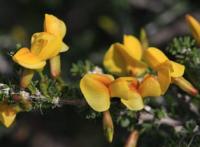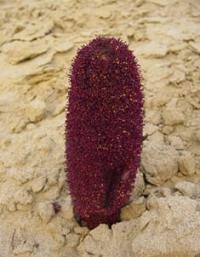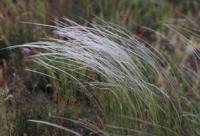Вы здесь
Flora of Khazar Reserve.



Vegetation of Khazar Reserve.
“The forests are dense - there are reeds along the banks;
Beauties in silver are replete with a living flower garden;
There is a gray sheep, a white horse, a black bull,
There is a buffalo and a tour: Gurgen's cattle are plentiful!"
"Gurgen". Translation by A. Tarkovsky. Makhtumkuli.
Visiting to reserves of Turkmenistan.
The vegetation cover is based on communities of macrophytes in shallow bays and coasts. About 40 species of algae (green, red and characeae) and 5 species of flowering plants (comb pondweed, etc.) participate in their composition.
In the Krasnovodsk Bay, accumulations of charophytes are noted in Bekovich Bay and in the area of the Osushnye Islands. Here, migratory birds accumulate in shallow waters, feeding on the algae themselves and the invertebrates living in them.
Phytomass reserves in the water area of the reserve reach hundreds of thousands of tons, ensuring high productivity of marine ecosystems. The flora of vascular plants of the reserve includes more than 360 species, however, the inventory of the flora has not yet been completed.
Its core is formed by plants of various types of deserts, as well as succession rows of dry coastal areas. A diverse group of halophytes from fresh continental areas, solonchaks and former lagoons. Coastal vegetation is represented here by a kind of ecological and genetic series of communities on a relatively narrow abrasion-accumulative seaside terrace.
Sarsazan and psammophyte groups predominate on the coast of the Gasankuli site. Moreover, at low levels (1.5 - 2.5 meters above the level of the Caspian Sea) there are mainly solonchaks with thickets from are azan, higher on sandy soils - communities with a predominance of kan-smoke, cherkez, astragalus, on gray-brown - wormwoods.
About 530 species of higher flowering plants, of which about 75 are endemic; 41 species of algae and 5 species of higher hydrophytes inhabit the sea bays. The vegetation cover is based on macrophyte communities of shallow bays and coasts.
About 40 species of green, red and characeae algae and 5 species of flowering plants (comb pondweed, etc.) participate in their composition. In the Turkmenbashi Bay, accumulations of charophytes are observed in the Bekovich Bay and in the area of the Osushny Islands.
Here, birds accumulate in shallow waters, including more than 360 species belonging to 185 genera and 35 families: Asteraceae - more than 18%, Chenopodiaceae - 13%, Fabaceae - 11%. However, the inventory of the flora is not yet completed and needs to be clarified.
The core of the flora is formed by plants of various types of deserts, as well as succession series dry areas of the coast. The group of halophytes of fresh continental areas, solonchaks and former lagoons is diverse. Coastal vegetation is represented here by a kind of ecological and genetic series of communities on a relatively narrow abrasion-accumulative seaside terrace.
On the coast of the Esenguly site, sarsazan and psammophyte groups predominate, and at low levels (1.5 - 2.5 meters above the level of the Caspian Sea) there are mainly solonchaks with thickets of sarsazan (Halocnemum strobilaceum), higher on sandy soils - communities with a predominance of kandym ( Calligonum litvinovii), cherkez (Salsola richteri), astragalus (Astragalus arpilobus, A. ammodendron), on gray-brown - wormwood (Artemisia deserti, A. kelleri).
On the coast of the North Cheleken Bay, the vegetation cover is relatively sparse and heterogeneous. Less than 50 species of higher plants grow here. In terms of life forms, the flora of the peninsula is dominated by annual herbs, especially ephemera, which make up about 60%.
Perennial winter-spring grasses (ephemeroids) generally cover 25-30% of the total species composition. Shrubs, semi-shrubs and semi-shrubs are few in number, about 10 - 13%. A significant part of the deserts of the Cheleken Peninsula, especially in the coastal strip, is occupied by salt marshes devoid of vegetation. Only along their edges grow rare halophytic plants.
On the area of moderate salinity - tree-like saltwort (Salsola dendroides), woolly saltwort (Salsola lanata), and for heavily saline areas - saltwort is characteristic Caspian (Halostachys caspica), narrow saltwort (Salsola angustata), Transaxian saltwort (Salsola transhyrcanica).
There are thickets of camel thorn (Alhagi persarum). Along the coast you can identify the following main plant groups: Circassian - occupy large areas in the northern part of the peninsula, creating semi-overgrown sands with the dominance of suzen (Ammodendron eichwaldii) and cherkez (Salsola richteri) in the shrub layer, patlak (Astragalus transcaspicus) - in semi-shrub; saltpeter - the background species is the saltpeter - kiyak (Nitraria komarovii), which grows in the coastal and southern parts of the peninsula on fine dune hilly sands on low relief elements, is common on the periphery of shore basins.
In the simplest version, this association consists of 3 species - saltpeter (Nitraria komarovii), selin (Stipagrostis karelinii) and smirnovia (sezenek - Smirnowia turkestana). The ephemeroid herbaceous flora is represented by such perennial herbs as Hohenacker's feather grass (Stipa hohenackerana), bulbous bluegrass (Poa bulbosa), sandy sedge
(Carex physodes), which have time to go through the entire cycle of their development within a few spring weeks, provided with moisture. The herbaceous cover is sparse, vegetates only in March-April, in May the grass burns out.
The coast of the Khazar section as a whole has more variants of primary succession communities. Here, dunes are common, almost devoid of vegetation, with single specimens of seline (Stipagrostis karelinii), sandy islands and spits with thickets of comb (Tamarix), coastal rush (Juncs littoralis), etc.
In areas of former lagoons, sarsazan forests are developed, on solonchaks, along depressions - communities of saltpeter and other succulent halophytes. At higher levels (2.5 - 5 meters), typically desert phytocenoses are formed with astragalus, hair and wormwood paniculate.
On the Darja Peninsula, there are fragments of communities of white saxaul (Haloxylon persicum), cherkez (Salsola richteri), saltpeter (Nitraria komarovii) and kandym (Calligonum litvinovii.). Of the semi-shrubs, there are also wormwood (Astemisia deserti, A. kelleri), sarsazan (Halocnemum strobilaceum), several types of saltwort (Salsola rigida - clumsy saltwort; Salsola arbuscula - tree-like or boyalich; Salsola gemmascens - kidney-bearing, or tetyr), Eichwald's parnolist (Zygophyllum eichwaldii), sickle-shaped astragalus (Astragalus arpilobus), tree-like astragalus (A. ammodendron), etc.
Vegetation complexes characteristic of weakly fixed dunes are also presented here. The actual zonal vegetation of the reserve occupies a small area. On sandy desert soils, these are associations of white saxaul with cherkez, badkhyz and paniculate wormwood, swollen sedge, ephemera (more than 30 species) and ephemeroids (including bulbous bluegrass).
On brown and gray-brown soils - communities of Badkhyz wormwood with dry saltworts, tetyr, etc. Reed, reed and cattail thickets are developed on the floodplain and in some parts of the coast; on the islands where there are colonies of gulls and terns, by the end of summer, ornithogenic groups of quinoa.
At higher hypsometric levels, the development of the vegetation cover of the reserve is determined by seasonal, annual and long-term cycles of moisture. So, almost every second winter (in Esenguly - 70 - 80% of winters) is favorable for vegetation and early development of ephemera.
Usually in March, when the most precipitation falls (about 20 mm on average), mass flowering of ephemera begins - annual fires, poppies, cruciferous, etc. Especially wet years (every 10 - 12 years) synusia of ephemers and ephemeroids reach their maximum development.
At low levels, due to the rise of water in the sea, one should apparently expect a halophytization of the vegetation cover. On the eastern coast of the Caspian Sea, one species of lichen is found - pitted teloschistes (Teloschistes lacunosus and 5 species of flowering plants included in the second edition of the Red Book of Turkmenistan (1999).
These are Trans-Caspian saltwort (Salsola transhyrcanica), Cheleken climacoptera (Climacoptera czelekenica), critmolistny (Malocarpus crithmifolius, relic), mossy lasiopogon (Lasiopogon muscoides), Eichwald sand acacia (Ammodendron eichwaldii).
Geographical coordinates of Khazar Reserve: N37°39'57.59" E53°52'40.54"
Authority:
"Reserves of Central Asia and Kazakhstan". Under the general editorship of R.V. Yashchenko. Tethys edition. Editorial Board of the Scientific Society "Tethys": R.Ya. Yashchenko chairman), O.V. Belyalov, V.P. Krivenko, O.E. Lopatin, I.V. Mitrofanov, K.M. Pachikin. Marmazinskaya N. July 25, 2006. Berkeliev T. http://iucnca.net
Photos by
Alexander Petrov.







